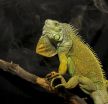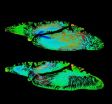(Press-News.org) SALT LAKE CITY, Nov. 17, 2014 - Whether birds are breathing in or out, air flows in a one-directional loop through their lungs. This pattern was unexpected and for decades, biologists assumed it was unique to birds, a special adaptation driven by the intense energy demands of flight.
But that view is wrong, according to University of Utah scientists who now have shown that bird-like breathing also developed in green iguanas - reptiles not known for high-capacity aerobic fitness. The finding bolsters the case that unidirectional bird-like flow evolved long before the first birds, arising nearly 300 million years ago in a common ancestor of lizards, snakes, crocodiles and dinosaurs including birds.
"We thought we understood how these lungs work, but in fact most of us were completely wrong," says Colleen Farmer, an associate professor of biology at the U and lead author of the new study published today in Proceedings of the National Academy of Sciences. "People have made a lot of assumptions about how lungs work in animals such as reptiles and crocodiles but they never actually measured flow," she says.
In humans and other mammals, lungs have airways with a tree-like branching structure. A main trunk in each lung splits into branches and twigs. Air flows in and out in a tidal fashion. Oxygen and carbon dioxide pass to and from blood in tiny air sacs, called alveoli, at the tips of the smallest airway branches.
In bird lungs, air loops in one direction through a series of tubes lined with blood vessels for gas exchange. Aerodynamic forces act like valves to sustain the one-way flow through cycles of inhalation and exhalation.
"For years, people thought that the design evolved to meet the energetic demands of flight," Farmer says. "That's all wrong. Iguanas don't fly."
Alligators also have a bird-like pattern of airflow. Farmer and Kent Sanders, a radiologist at the U, revealed that in a 2010 study. It was the first evidence that one-directional lung ventilation might be an innovation pre-dating the origin of birds. Earlier this year, Farmer along with Emma Schachner and Robert Cieri at the U, and James Butler of Harvard University reported that monitor lizards have one-directional airflow through their lungs, too.
Those discoveries left open the possibility that crocs and monitor lizards evolved their bird-like lungs independently, that is, their evolution converged on a design similar to birds. The finding of bird-like lungs in yet another group of reptiles builds a stronger case for an origin in the remote past in a common ancestor.
To make the discovery, Farmer and co-authors Cieri, Schachner and Brent Craven of Pennsylvania State University had to find a way to visualize air moving through iguana lungs. In one set of experiments, they used a surgical scope to look inside the lungs of live iguanas as the lizards inhaled harmless smoke from a theatrical fog machine. They also used probes that measure air speed and volume in dissected lungs. Working from 3-D X-ray imaging of the contours of iguana lungs, Craven made a computer model simulating airflow. The model's predictions closely matched the patterns observed in real lungs. "It was dead-on with the directions of flow we observed," Farmer says.
The revelations make clear that scientists have much to learn about the physiology of lungs in species other than mammals. Textbooks generally assert that air moving in and out of lungs flows down a pressure gradient from a point of higher pressure to one of lower pressure, but Farmer says her group's findings show that in iguana lungs "that's not what's going on at all." The shapes and angles of the lung airways point jets of air that create one-directional flow.
The mechanics aren't fully known yet, but Farmer says a better understanding could inspire new ways to design devices that circulate or filter blood or other fluids without using mechanical valves. "The geometry of these lungs, it is so weird," Farmer says, "I don't think any engineer would dream that up."
INFORMATION:
University of Utah Communications
75 Fort Douglas Boulevard, Salt Lake City, UT 84113
801-581-6773 fax: 801-585-3350
unews.utah.edu
MONTREAL: An infant's mother tongue creates neural patterns that the unconscious brain retains years later even if the child totally stops using the language, (as can happen in cases of international adoption) according to a new joint study by scientists at the Montreal Neurological Institute and Hospital - The Neuro and McGill University's Department of Psychology. The study offers the first neural evidence that traces of the "lost" language remain in the brain.
"The infant brain forms representations of language sounds, but we wanted to see whether the brain maintains ...
November 17, 2014--Museum biological collections are the records of life on Earth and as such, they are frequently used to investigate serious environmental issues. When public health officials were concerned about the levels of mercury in fish and birds, for example, scientists studied museum specimens to assess historical changes in mercury contamination. Eggs in museum collections were analyzed to establish the connection between DDT, thinning eggshells, and the decline in bird populations. And now, specimens from the Natural History Museum of Los Angeles County (NHM) ...
CHICAGO - Black patients who have been diagnosed with heart failure are no less likely than white patients to get atrial fibrillation (an irregular heartbeat, or arrhythmia), according to a new study led by researchers in the Perelman School of Medicine at the University of Pennsylvania, which was presented today at the 2014 Scientific Sessions of the American Heart Association. These findings run counter to previous studies, which have found that black patients with heart failure tend to have less atrial fibrillation problems than white patients.
"Even though ...
ROCHESTER, Minn. -- The investigational drug ixazomib taken orally in combination with lenalidomide and dexamethasone shows promise in patients with newly diagnosed multiple myeloma, according to the results of a phase 1/2 study published in the journal Lancet Oncology.
"Ixazomib is an investigational, oral proteasome inhibitor with promising anti-myeloma effects and low rates of peripheral neuropathy," says Shaji Kumar, M.D., a hematologist at Mayo Clinic and lead author of the study. "While it is well known that a combination of bortezomib, lenalidomide and dexamethasone ...
iRhythm Technologies, Inc. announced today that study results presented during the American Heart Association (AHA) Scientific Sessions showed an association between a high burden of atrial fibrillation (AFib) and lower cognitive function, specifically executive and verbal function. Previous studies have shown a relationship between AFib, cognitive decline and increased risk of dementia. However, this study, which was led by researchers at the University of Minnesota, demonstrates for the first time a correlation between high AFib burden - the percent of time a person has ...
Amsterdam, NL, 17 November 2014 - Two simple tests conducted during the neurological exam can help clinicians differentiate between early-stage Parkinson's disease (PD) and atypical parkinsonism. By asking patients to perform a tandem gait test and inquiring whether they are still able to ride a bicycle, clinicians can ascertain whether medio-lateral balance is impaired, a defining characteristic of atypical parkinsonism. These findings are published in the Journal of Parkinson's Disease.
This issue of the Journal of Parkinson's Disease also marks the inauguration of ...
Why is Jamaica, with a population smaller than that of Los Angeles, home to so many of the world's elite sprinters - runners who compete in the 100, 200, 400 and 800-meter races?
Robert Trivers, an evolutionary biologist and professor of anthropology and biology in the School of Arts and Sciences, set out with his colleagues to find out if there was something about the symmetry of their knees that might partly explain this phenomenon. They already knew from their earlier research that the symmetry of children's knees at age 8 predicts how fast a person runs 14 years later ...
The sun emitted a mid-level solar flare, peaking at 12:48 p.m. EST on Nov. 16, 2014. NASA's Solar Dynamics Observatory, which watches the sun constantly, captured an image of the event. Solar flares are powerful bursts of radiation. Harmful radiation from a flare cannot pass through Earth's atmosphere to physically affect humans on the ground, however -- when intense enough -- they can disturb the atmosphere in the layer where GPS and communications signals travel.
To see how this event may affect Earth, please visit NOAA's Space Weather Prediction Center at http://spaceweather.gov, ...
Here's another reason to pay close attention to microbes: Current climate models probably overestimate the amount of carbon that will be released from soil into the atmosphere as global temperatures rise, according to research from the US Department of Energy's Lawrence Berkeley National Laboratory (Berkeley Lab).
The findings are from a new computer model that explores the feedbacks between soil carbon and climate change. It's the first such model to include several physiologically realistic representations of how soil microbes break down organic matter, a process that ...
Fruit flies do not always conform to the norm. When female fruit flies have to decide where to lay their eggs, they take their lead from what they see most others in their group do. However, some do take their personal preferences into account. So says Marine Battesti of the Université Paris-Sud in France, lead author of a study in Springer's journal Behavioral Ecology and Sociobiology.
The site on which an insect chooses to lay her eggs is very important for the development and survival of future generations. Such choices are not fixed, but are influenced by the ...




